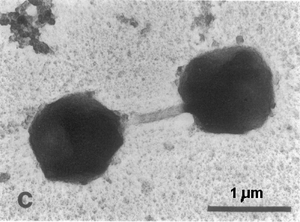Hyperthermus butylicus: Difference between revisions
| Line 35: | Line 35: | ||
==Description and significance== | ==Description and significance== | ||
Hyperthermus butylicus is under Archaeal kingdom Crenarchaeota. This aquatic anaerobe is found near the coast of the island of São Miguel, Azores. Found in temperatures as high as 112C°, H. butylicus has a broad temperature optimum of 95 to | Hyperthermus butylicus is under Archaeal kingdom Crenarchaeota. This aquatic anaerobe is found near the coast of the island of São Miguel, Azores, Portugal. Found in temperatures as high as 112C°, H. butylicus has a broad temperature optimum of 95 to 107C°. Thermophilic archaebacteria uses H2S formation only as an accessory energy source. Its main mode of energy is fermentation. | ||
H. butylicus carries superoxide reductase and peroxyredoxin that removes superoxides without producing O2. Superoxides are harmful to organisms due to its free radical state. | |||
The removal of superoxides without making O2 keeps the electric gradient of the inside relatively negative compared to the outside. | |||
==Genome structure== | ==Genome structure== | ||
Revision as of 00:27, 3 June 2007
Welcome to MicrobeWiki
Microbial Biorealm * Viral Biorealm * Microbial World News * Microbial Mythology
MicrobeWiki is a free wiki resource on microbes and microbiology, edited by students and monitored by microbiologists at Kenyon College. We invite you to use our Microbe Wiki to study the microbial world with us. You are encouraged to add information, after registering a free account.
Educators: You may assign MicrobeWiki page creation and editing as projects for your students. We create a template page for your assignment, which you may edit to meet your needs. See for example the pages created by Dr. Kirk Bartholomew's microbiology class at Sacred Heart University. Your students receive individual passwords. Assessment and "grading" are up to you; after your class is over, we review pages for our standards. Students of all levels, from first-year to graduate students, have contributed pages to our site.
MicrobeWiki includes these modules:
Microbial Biorealm: encylopedia of bacteria, archaea and eukaryotic microbes. See also Taxonomy Index.
Viral Biorealm: encyclopedia of viruses of animals and plants, and bacteriophages. See also Taxonomy Index.
Microbial World News: highlights of microbiology in the news.
Microbial Mythology: common errors and controversies in microbiology.
Managing Editor
Daniel Barich '05 A Microbial Biorealm page on the genus Hyperthermus butylicus

Classification
Higher order taxa
Archaea; Crenarchaeota; Thermoprotei; Desulfurococcales; Pyrodictiaceae
Species
Hyperthermus butylicus
|
NCBI: Taxonomy Genome |
Description and significance
Hyperthermus butylicus is under Archaeal kingdom Crenarchaeota. This aquatic anaerobe is found near the coast of the island of São Miguel, Azores, Portugal. Found in temperatures as high as 112C°, H. butylicus has a broad temperature optimum of 95 to 107C°. Thermophilic archaebacteria uses H2S formation only as an accessory energy source. Its main mode of energy is fermentation.
H. butylicus carries superoxide reductase and peroxyredoxin that removes superoxides without producing O2. Superoxides are harmful to organisms due to its free radical state. The removal of superoxides without making O2 keeps the electric gradient of the inside relatively negative compared to the outside.
Genome structure
The genome of Hyperthermus is currently being sequenced by the group from the University of Copenhagen. The G + C content of the DNA is around 55%.
Cell structure and metabolism
Hyperthermus butylicus resembles the shape of Sulfolobus. They form irregular spheres with flat surfaces. Pili are found on the surface. Vacuoles are also found below the S layer.
H. butylicus has several ways to harvest energy. It utilizes sulfur reducing enzymes such as hydrogenase to harvest energy by reducing elemental sulfur to H2S. The addition of elementary sulfur and H2 significantly helped the growth and formation of H2S. Sulfur reduction is an important way to make energy for H. butylicus. The functional protein complexes that are bound to the surface of membranes catalyze sulfur reduction to H2S.
It also uses peptide mixtures as carbon source, but cannot use amino acid mixtures, synthetic peptides, or undigested protein. No chemolithoautotrophic growth was found without the peptide mixtures as carbon source. In absence of the elementary sulfur and H2, it acquired nitrogen from NH4+ ions.
H. butylicus is the first archaebacterium to have its fermentation products identified. Fermentation occurs with and without the presence of elementary sulfur and H2. Fermatation products include CO2, 1-butanol, acetic acid, phenylacetic acid and a trace of hydroxyphenyl acetic acid.
Ecology
Samples were taken near the coast of the island of São Miguel in Azores, Portugal. Hyperthermus butylicus ispopular under 40cm under sand along the gas vents that release steam, CO2, and some H2S. The pH of the environment is about 7 and salt optimum of 17g of NaCl per liter.
H. butylicus has a broad temperature optimum of 95 to 107C°. It can survive temperature as high as 112C°. It goes through genetic changes to assimilate into higher temperatures.
References
Kenyon Student Editors, 2002-2007
Ryo Tashiro '09, Molly Schlemmer '08, Shrochis Karki '09, Drew Taber3, Allison Whipple '06, Zeva Levine1, Laura Damon-Moore1, Ariel Kahrl2, Hannah Sacks '08, Michael Stulberg '05, Casey M. Smith '06, and Shana Scogin '07
Advisor: Joan Slonczewski, Biology Dept, Kenyon College
Guest editors from 1Beloit, 2Oberlin, and 3Columbia Union College.
Funded by HHMI awards to Kenyon College, 2000, 2004.
Copyright notice. Readers may view, browse, and/or download material for
noncommercial personal purposes. Please credit our site for use. Materials on our site obtained with permission from other sources require permission from those sources
for further reproduction.
Disclaimer. Information on this site is provided solely for educational purposes. Medical questions should be referred to a physician.
